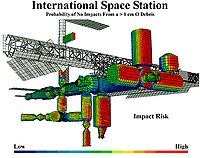
Photo from wikipedia
The convergence of nanotechnology and biotechnology has led to substantial advancements in nano-biomaterials (NBMs) used in medical devices (MD) and advanced therapy medicinal products (ATMP). However, there are concerns that… Click to show full abstract
The convergence of nanotechnology and biotechnology has led to substantial advancements in nano-biomaterials (NBMs) used in medical devices (MD) and advanced therapy medicinal products (ATMP). However, there are concerns that applications of NBMs for medical diagnostics, therapeutics and regenerative medicine could also pose health and/or environmental risks since the current understanding of their safety is incomplete. A scientific strategy is therefore needed to assess all risks emerging along the life cycles of these products. To address this need, an overarching risk management framework (RMF) for NBMs used in MD and ATMP is presented in this paper, as a result of a collaborative effort of a team of experts within the EU Project BIORIMA and with relevant inputs from external stakeholders. The framework, in line with current regulatory requirements, is designed according to state-of-the-art approaches to risk assessment and management of both nanomaterials and biomaterials. The collection/generation of data for NBMs safety assessment is based on innovative integrated approaches to testing and assessment (IATA). The framework can support stakeholders (e.g., manufacturers, regulators, consultants) in systematically assessing not only patient safety but also occupational (including healthcare workers) and environmental risks along the life cycle of MD and ATMP. The outputs of the framework enable the user to identify suitable safe(r)-by-design alternatives and/or risk management measures and to compare the risks of NBMs to their (clinical) benefits, based on efficacy, quality and cost criteria, in order to inform robust risk management decision-making.
Journal Title: Materials
Year Published: 2020
Link to full text (if available)
Share on Social Media: Sign Up to like & get
recommendations!